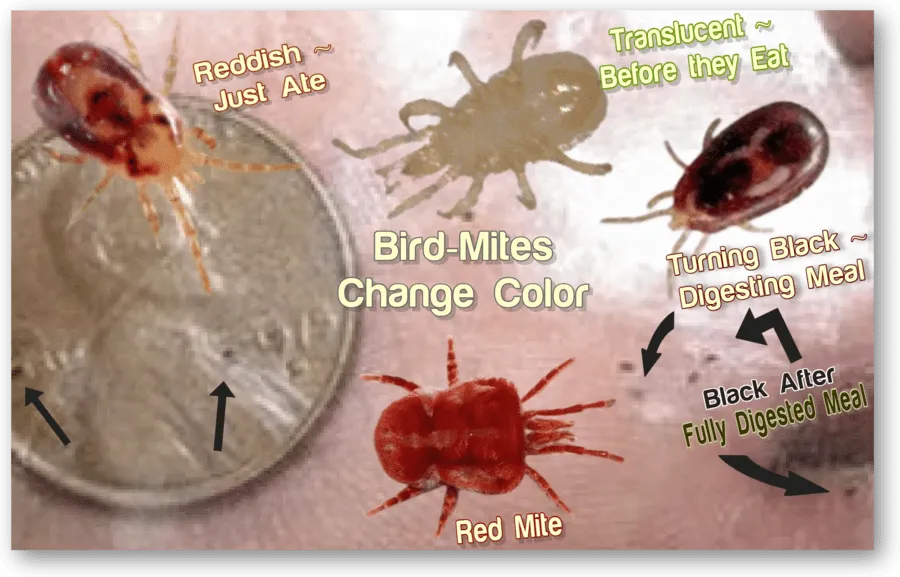If you’ve ever wondered what bird mites are, what they look like, how to spot them, and most importantly, how to get rid of them. Well then, you’ve come to the right place. I hope this article offers you a better understanding of what they are so not to be fearful of mites, but instead be empowered to prevent or eradicate any and all mites should your birds already have them.
What Exactly Are Bird Mites:
Bird mites, also known as chicken mites, are tiny little bloodsucking parasites that can cause serious harm to your birds. To put things in perspective, a bed bug is 5-7 mm in size, whereas an adult bird mite is only 1 mm in size. To say they are small is an understatement, but they are nasty all the same. If you are not proactive and fail to swiftly eradicate them from your birds’ skin, feathers, and living spaces, including nests, then it’s safe to say that it won’t take long till you start finding dead birds in your coop or loft. Mites have razor-sharp mouths they use to penetrate the skin and feed on the blood of a host. If you are fortunate enough to never have been bitten by one, it stings and leaves red bumps and rashes on the surface of the skin. So, you can imagine how much worse it will be for your birds than for you. Let’s be honest. For you, it could mean feeling irritation on the skin, but for your birds, it can mean death. The answer is simple: Don’t Wait; “Take Immediate Action”.
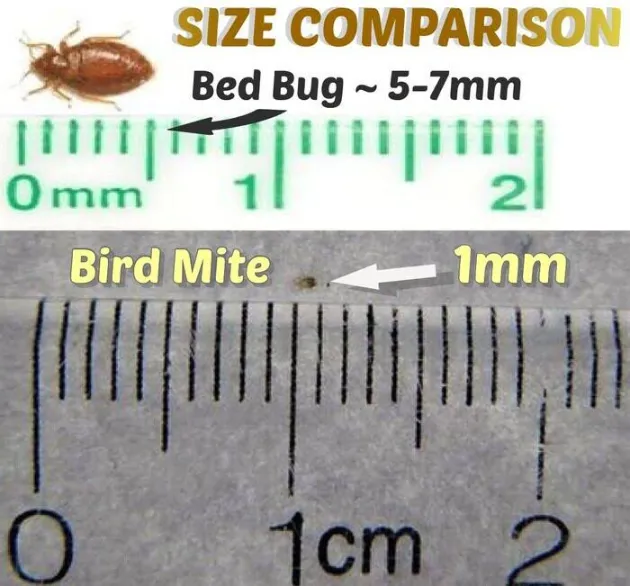
What Do Mites Look Like:
A bird mite is one of several different colors, meaning the mite’s color will change according to its feeding schedule. With that in mind, when a mite has not yet eaten, it will have a whitish-grayish, translucent color, a flattened oval body covered in short hairs, and eight legs. Yep…go ahead…say it…yuck! Now, their coloring will change after biting and feeding on the blood of a host. At that point, they will turn a reddish color. After the blood or meal digests, they will turn a black or darker grayish color. This is usually when you can easily spot them when lifting up to see the underside of a bird. Unless you have an excessive infestation, at which time you would see them covering and crawling all over your birds. Let’s hope you demonstrate your due diligence before that happens.
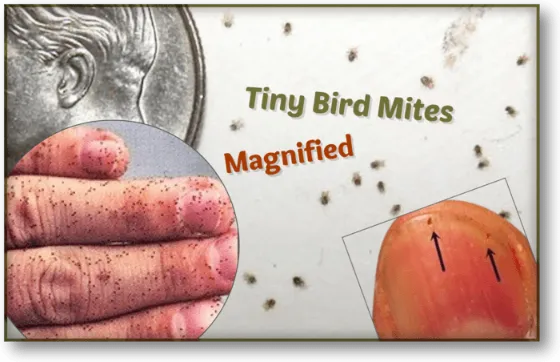
Do Your Birds Have Mites? What To Look For:
- Spring and summer’s hot, humid days and nights attract mites.
- Dirty, poopy nest bowls, perches, and loft or coop floors
- Do your birds peck at themselves frequently?
- Do your birds dance on their perches, day or night?
- Do you see your birds itching and scratching themselves?
- Are your birds steadily preening themselves?
- Are your birds beginning to look a bit rough, lacking energy, or not really interested in eating?
- Do babies in the nest seem quieter and not beg for food?
- Do they show signs of red, irritated skin?
- Do a close visual inspection of the wings and feathers of birds; you will then be able to see the mites on their skin and in their feathers.
- Some have said to put cotton balls in the nest bowl at night and pick them up right away in the morning. This trick is supposed to show you if you have mites or not.
- Mites are nasty little buggers that can live in wall crevices, entering through window cracks and door cracks, not to mention under roof cracks or openings. I can’t stress enough the importance of having a well-built coop or loft that’s fully insulated. They frequently appear in tenfold at night when birds are sitting still in one place, being chewed on all night. If this is happening in your loft, your birds will eventually die if you don’t solve the problem.
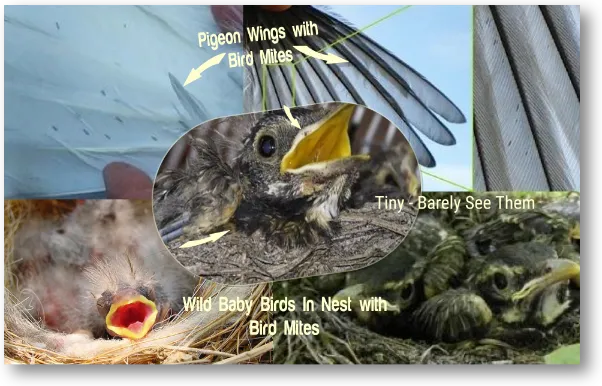
ALSO, Take Note: it’s very important to be aware of other birds around your property… Wild, random birds building nests on or near your structures can be carriers of or attract mites to your lofts. This too can cause serious issues in your own home when you allow wild birds to build nests on or near your house structure, providing mites with an entry point into your home. Not to mention, it goes without saying, “Don’t allow wild birds,” i.e., sparrows, starlings, pigeons, or other wild birds, into your loft or coop.
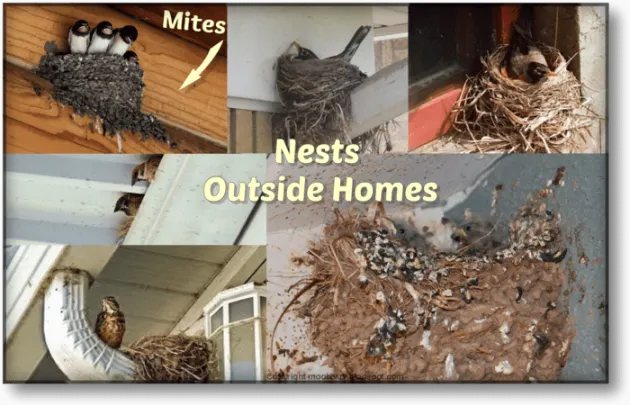
Now, I’m not saying that every nest you encounter on your property will be infested with bird mites, but it never hurts to be aware and vigilant. Personally, when I stumble upon a wild bird’s nest and spot mites crawling in and around the nest as well as on babies in the nest, I would then take the Raid spray I mention below and carefully spray the babies and all over the nest. After seeing something like that, you can’t in good conscience just turn a blind eye and walk away.
How To Remedy the Problem Immediately:
- Sevin Dust – We’d sprinkle chicken powder under nest bowls and on carpets glued inside the bottoms of the nest bowls, then cover with straw. (If you also have chickens with mites, sprinkle right on them and/or sprinkle in sand dirt hole they like to dry bath in.)
- Borax or Sevin Dust – After cleaning your coop, sprinkle Borax or Sevin Dust on the floor where the poop usually piles up (usually just below the perches on the floor where birds sit and poop over the side to the floor). This can make the floor under the poop moist and a bit wet. This will then breed mites. Sprinkle the Borax or Sevin Dust down, take a scraper to spread it around, and then (very important!) scoop the Borax or Sevin Dust back up again so the birds can’t eat it. This will help your coop stay dryer and healthier.
- Raid – Emergency Care: In hot summer days, use the blue can of Raid Flying Insect Spray to spray under wings to kill mites on contact.
- Wazine – Put Wazine in bath water—good for a mild case of mites.
- Ivermec: External – Put Ivermec in bath water—good for parasites or bug infestations externally. Read directions, put in 5 gal bucket of water
- Ivermec: Internal – Put in drinking water for internal parasites. This will pretty much kill everything. Follow directions carefully so as not to give them too much.
- Borax – Put borax laundry powder in bath water; this is good for cleaning feet and dander in feathers as well. This is what I use 99% of the time because my birds just want to take a bath and get clean. I normally do not have a bug problem as we are rather diligent in keeping lofts and birds clean, but in my 1% case, I would then revert to utilizing one of the above solutions to whip out any problem. After which, I would handle every single bird I have each day for the next several days to ensure there isn’t a bug or mite to be found.
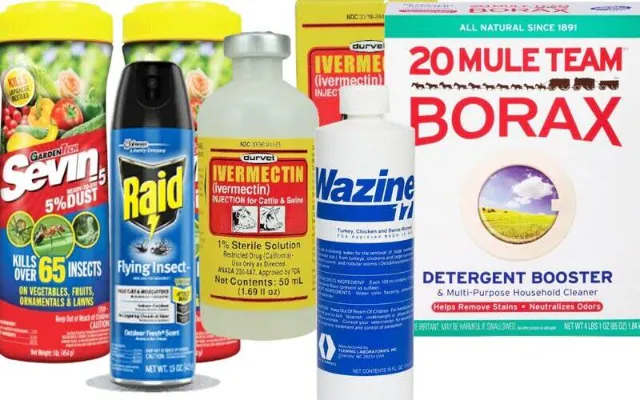
NOTE: Keep in mind that when you’ve scraped and cleaned out your coop or loft from top to bottom, to kill any hidden mites in crevasses, you can sprinkle the Sevin Dust on floor, perches, and in cracks, or mix up some Ivermec with water in a spray bottle and spray around inside and outside your coop.
QUICK TIP: (If you also have chickens, you can use this same spray bottle method to spray their legs, skin, and feathers. Add Sevin Dust to the loose sand or dirt hole where your chickens like to dry wash themselves.) Then walk into your coop in the dark with a flash light. Observe the behavior of your birds. Are they restless and dancing around, or are they quiet and clam? (Hopefully you read my article on mosquito control and took action so they are not dancing because of mosquito bites.) Look around your perches and nest bowls to see if you can see any mites crawling on and biting your babies or adult pigeons. If all goes well and all looks good, then congratulations! You were successful. Now try to keep it that way… LoL
IN CONCLUSION:
I feel I must be transparent with you. There are several species of bird mites, of which I have showcased two of those species above. Now, normally, I only post pictures of my birds, lofts, etc., that I took myself. But, in this post, I was forced to pull some photos from online and create my own from there since I don’t have any photos of bird mites on my own birds, or chickens, for that matter. In fact, I have never owned a dog or a cat that has ever had lice, fleas, mites, or anything of that nature. I find the occasional tick here and there on my dogs, but I do a thorough check several times a day when we venture out into the woods, at which time I remove it immediately when I do find one. Other than that, my animals are bug-free. Please know that I am not saying this for bragging rights or anything of that nature; I am simply putting it out there. In my experience, keeping all the living environments of my animals clean, dry, and healthy appears to keep the bugs away. Now, I never said my birds never had bird mites; I said it was rare. And during those few times, I never took any photos (hence I’m using royalty free images I found online and then made my own design out of them), but never the less, mites do thrive in the hot, humid summer weather. As a result, the likelihood of mites simply appearing is fairly high within that climate, at which point I will exterminate them the second I spot any. So all in all, I must be doing something right… Lol, but in all fairness, I will admit that I do have an advantage: I always give thanks to the good “Lord” above, say my daily prayers, and ask for his never-ending protection. He’s never forsaken me yet… LoL.
Ok, so now you have the gist of what mites are, what they look like, what attracts mites, and how to rectify the problem to keep your birds happy and healthy. I hope you found this info helpful. That’s all for now; drop us a line if you have any questions.

